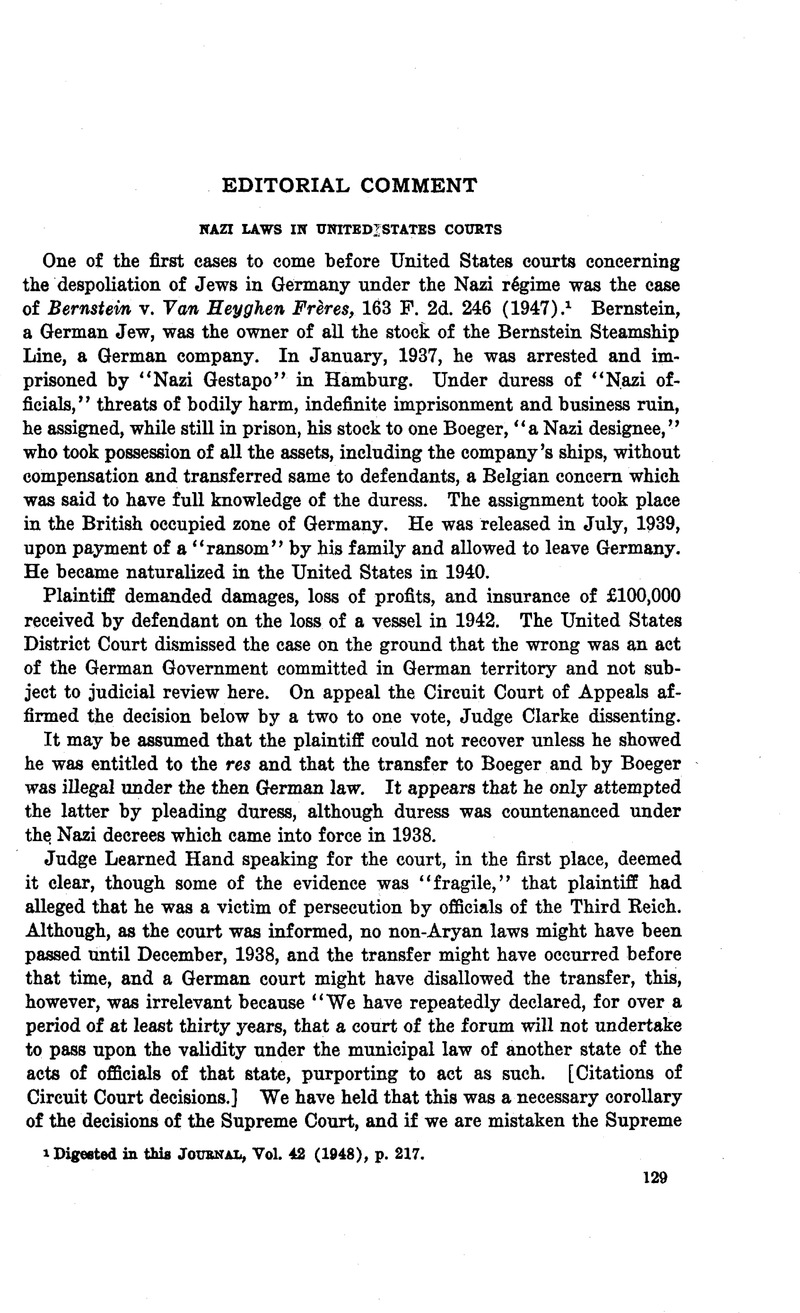Published online by Cambridge University Press: 20 April 2017

1 Digested in this Journal, Vol. 42 (1948), p. 217.
2 Petition for certiorari was denied by the Supreme Court, 332 U. 8. 772.
3 Petrogradsky v. National City Bank, 253 N. Y. 23; Salimoff v. Standard Oil Co., 262 N. Y. 220; Vladikavkajsky Ry. v. N. Y. Trust Co., 263 N. Y. 369; U. S. v, N. Y. Bank and Trust Co., 77 F. 2d 866; U. S. v. Belmont, 85 F. 2d 542, 301 U. S. 324; U. S. v. Pink, 215 U. S. 203. See discussion of cases in 23 N. Y. U. Law Quart. Rev. (1948), Notes, p. 311; also by Jessup, in this Journal, Vol. 31 (1937), p. 481 Google Scholar, and ibid., Vol. 36 (1942), p. 232; Borchard, ibid., Vol. 31 (1937), p. 675; and King, ibid., Vol. 42 (1948), p. 811. It may be noted in passing that the confiscation of property of aliens is regarded as a violation of international law. Anderson, C. P., this journal, Vol. 21 (1927), p. 525 Google ScholarPubMed.
4 The Allied Declaration of June 5, 1945, assuming “supreme authority with respect to Germany including all the powers possessed by the German government, the High Command or any state, municipal or local government or authority”; the Potsdam agreement of Aug. 2, 1945, establishing the Supreme Council and enacting that all Nazi laws of the Hitler régime discriminating in respect of “race, creed, or political opinion shall be abolished. No such discrimination, whether legal, administrative or otherwise shall be tolerated”; Military Government Law No. 1 and Law No. 52 of the United States Zone. Judge Clarke also mentioned the Directive of April, 1945, and Allied Council Law No. 1.
5 It appears from the Judgment at Nuremberg that “The Tribunal therefore cannot make a general declaration that the acts before 1939 were crimes against humanity within the meaning of the Charter…” (Judgment, p. 84).
6 Digested in this Journal, Vol. 42 (1948), p. 726, Vol. 43 (1949), p. 180, and Vol. 44 (1950), p. 182.
7 He listed the following instruments in support of this statement : Inter-Allied Declaration of Jan. 5, 1943; Gold Declaration of Feb. 22, 1944; Potsdam Agreement of Aug. 2, 1945; Directives to U. S. Commander-in-Chief, April, 1945 and July 11, 1947; Allied Control Council Law No. 1; Military Government Laws Nos. 1, 52 and 59. He continued:
“Of special importance is Military Government Law No. 59 which shows this Government’s policy of undoing forced transfers and restituting identifiable property to persons wrongfully deprived of such property within the period from January 30, 1933 to May 8, 1945 for reasons of race, religion, nationality, ideology or political opposition to National Socialism. Article 1 (1). It should be noted that this policy applies generally despite the existence of purchasers in good faith. Article 1 (2).”
8 Dept. of State Bulletin, Vol. XX, No. 514 (May 8, 1949), pp. 592–593.
9 Anderson v. Transandine Handelmaatchappij, 289 N. Y. 9.
10 Republic of Mexico v. Hoffman, 324 U. S. 30; The Navemar, 303 U. S. 68; Ex parte Muir, 254 U. S. 622; Ex parte Peru, 318 U. S. 578.
11 This Journal, Vol. 27 (1934), p. 607. Mr. Moore was of counsel in the early stages of the Underhill case.
12 Besides the Underhill and Oetjen cases supra: Ricaud v. American Metal Co., 246 U. 8. 304; Ex parte Peru, 318 U. S. 578; Mexico v. Hoffman, 324 U. 8. 30; The Navemar, 303 U. 8. 68; American Banana Co v. United Fruit Co., 213 U. 8. 347; also several Circuit Court and State court decisions.
13 It may be recalled that the act of state doctrine has not been applied to acts of the judicial arm of government. Courts frequently scrutinize decisions of foreign courts for lack of jurisdiction, fair procedure, fraud and other evils disfavored by the public policy of the forum.
14 See footnote 4 above.
15 See the Special Report of the Military Governor, November, 1948 for the text of other Laws and Regulations. Such restitution was to be made by courts in Germany and not elsewhere. Up to this time the legislation in the American Zone provided only for restitution of identifiable tangible and intangible property (Law No. 59). On Sept. 30, 1949, the German Laender comprising the U. S. Zone promulgated legislation whereby certain classes of persons who suffered monetary and other losses through persecution by the Nazi régime, may receive indemnification for losses falling outside the previous restitution legislation. (State Department, Press Belease No. 759, Oct. 3, 1949; Bulletin, Vol. XXI, No. 537 (Oct. 17, 1949), pp. 591–592.)
16 Also it had been found impossible to make them uniform for all zones or even for two zones (Special Report of Military Governor, November, 1948, p. 22).